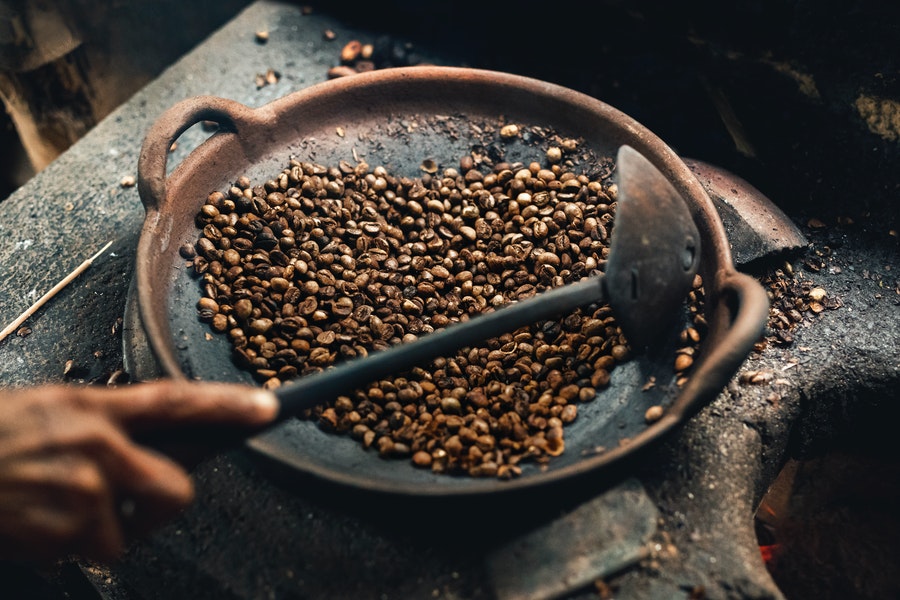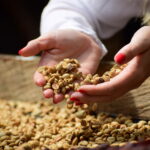Some coffee beans have a slick sheen, while others are dry and dull-looking. What does this mean? Why are some coffee beans oily? The oils present in the bean have a big impact on the coffee’s freshness and taste. The oil content in the beans can vary widely, so each type of bean will look or taste different. Here’s what you need to know.
Contents
Why Are Some Coffee Beans Oily?
Some coffee beans are oily because it helps to keep them fresh. As the beans age, they lose some of their natural oils and flavor. Oils can protect aging beans from developing a rancid taste. Brazilian and Colombian coffees are particularly known for having light, golden oils on their surface.

Oils in Coffee
There are different types of fats found in espresso beans: fatty acids (linoleic, linolenic), triglycerides (palmitic acid), wax esters, and phospholipids (soybean lecithin).
The type of oil in your roasts depends on how you like your cup of joe: lighter roasts tend to have less natural oils than darker ones, although both styles can be delicious depending on how you brew them.
Aging
The oils in your coffee beans can tell you how fresh they are and how well you have stored them.
Fresh Beans
When the beans arrive at a roastery, they are laid out on mesh screens to be dried. During this process, some of the moisture escapes, and some of the oils rise to the bean’s surface.
The resulting oily sheen is a natural part of the drying process and should not be confused with oil added by other means (such as during roasting).
Older Beans
The older your coffee gets, the more oil will be released from within it. If you leave fresh beans long enough, they will also become oily.
Suppose you leave them in your pantry for too long. They get a slick feeling because they’ve absorbed moisture from the air.
Roasting
Oily beans are a sign of good quality roasting. The oils that give the beans their unique texture and taste are created when you properly manage heat during roasting. You’ll notice that most high-quality beans have a bit of oil on them — it’s not just a visual effect!
Oils show that heat is being properly managed during roasting and brewing. When you roast the beans at too low a temperature, they won’t develop any natural oils or flavor compounds. A good roaster will use the right amount of heat at the right time to produce flavorful, aromatic beans that make great coffee.

How Oils Impact Coffee Flavor
- Fatty acids give coffee its characteristic earthy taste
- Triglycerides create sweetness
- Wax esters lend fruity flavors and beautiful aromas
- Phospholipids add notes of chocolate or butterscotch.
Different roasters use different techniques to bring out these flavors from their beans. Some use more heat and some less; some roast darker than others; others go for a shorter roasting time. All this affects how oily your coffee will be.
Tips to Brew Oily Coffee
To brew the best cup of oily coffee, make sure you use high-quality beans and follow these tips:
Choose a Coarse Grind
A medium-coarse grind is ideal for oily coffees because it allows more surface area for hot water to contact the grounds. This results in a richer extraction.
Use a Pour-Over Method
This brewing method allows you to control the temperature of your water so that it doesn’t boil over or burn your coffee. You also have better control over how long the hot water has to steep with the grounds, which helps extract more flavor from them.
Brew at a Lower Temperature of 195 Degrees Fahrenheit
Oily coffee requires less heat than regular coffee because its oils can burn if exposed to too much heat or steam. Using an automatic drip maker, use the pre-soak setting instead of bringing the water to a full boil. For manual brewing methods like pour-over or French press, use 195 degrees Fahrenheit as your target temperature instead of boiling water.
Related Questions
Is It Ok if the Espresso Beans Are Oily?
Yes, it’s OK if the beans are oily. As the coffee bean roasts, it releases oils and fats into its shell. If you’re buying green beans to roast yourself, you’ll want to make sure that they’re not overly oily before you roast them.
How Do You Make the Beans Less Oily?
You can make espresso beans less fatty by storing them properly after roasting. If you don’t plan to use your whole beans right away, then keep them in an airtight container in a cool dark place like a pantry or cupboard away from direct sunlight.
Conclusion
Why are some coffee beans oily? Some coffee beans may appear oily because it helps to keep them refreshing. As time passes, the beans will go stale if no protection is given. An oily surface can help keep your beans fresh and naturally flavored without changing their taste or quality.



